#constraints journal
Explore tagged Tumblr posts
Note
I read recently a meta that said that the reason for Ford didn't stand up for Stan in the principal's office was because he believed deep, deep down that what the principal was saying is truth and not because of a particularly strong fear of adult authority. Because Ford would have defended Stan if he weren’t already slowly internalizing and subconsciously agreeing with the things people said about his brother, or—at the very least—asked the principal about Stan’s fate, like Caryn did in his place.
What do you think?
we do know that ford ends up internalising the absolute worst of stan eventually but! personally i really don't think it was the case at the time of the principal meeting
i think it's kinda forgotten that stan has been constantly and openly badmouthed by those around him their whole lives and it's pretty hard to speak out when its done by authority figures and especially their dad (we know that their dad did so constantly to the point where stan still gets upset about it in the stan commentary)
however even if folks do interpret it as ford agreeing with the principal, i don't see why you can't also say that it wasn't a mix of both reasons?
stan is literally the most important person to him at the time but also i think the meeting hammered home that they've always been seen as a duo, where ford's accomplishments can't be brought up without mentions of stan when he's already starting to feel suffocated by always being seen as a twin and less of his own person (meanwhile stan has the opposite problem of not being able to perceive himself without the identity of being a twin and the following years of failure and pain just made that so much worse...)
but i think ford saying that stan will visit him across the country is his own way of rebuking the "stan will be stuck in new jersey forever" comment. ford knows full well that stan is his own brand of smart (and honestly the main reason stan's life went to hell is because he was suddenly dumped into poverty with no support, and the ultimatum of making a fortune as soon as possible just led to him landing himself in debt and a mile long criminal record before he was out of his teens)
(as for caryn bringing stan up during the meeting, it's probably a good thing that she's the one who asked about stan cos like. she only ended getting like 4 lines in the entire series lmao)
#there's also the ep in general being pretty fast paced cos of time constraints#the opinion we see ford having of stan in the journal is after years of forcing himself to resent him#it feels like ford tends to go 'i have to think the worst of this person otherwise it will mean i lost them over nothing'#and at his worst (aka post-portal) it's when he's at his most frustrated from missing his chance at killing bill#and being disorientated because he doesn't feel like he belongs in his own home anymore#(just rambling on about this cos i read another fic where the author went kinda overboard with making post portal ford an asshole lol)#(kinda a shame folks ignored that he kind of lightens up in the following eps and basically forgets his own ultimatum to stan#especially when stan drops his own side and lets dipper hang out with him)#hoping theres not too many typos in this its just another stream of rambles lol
13 notes
·
View notes
Text
I really wanted to love Arcane but after watching all of it I still find the majority of it really unfulfilling. Like, the animation really is gorgeous (as in, I literally think it's the prettiest/most smoothly animated show I've ever seen in my life and the action sequences especially were incredible) and I found basically all of the characters and their relationships initially really compelling but ultimately it just felt really empty to me.
So many characters' decisions/motivations (not all--there are a handful of obvious choices) seemed to shift aimlessly depending on what music video the creators wanted to make at the time, and the fact that the vast majority of characters actions feels reactionary to whatever outside force (the arcane/hex tech/black rose/whatever) they decided to invoke at the time was really annoying to me. Reactionary character choices aren't inherently bad, but when you have certain characters that everyone in the show plays up as strategic geniuses or powerhouses or whatever and then they also end up just kind of drifting along with whatever is thrown in to get them to end up wherever they ultimately need to be like dust motes and they don't end up being the actuators of basically anything at all in the end it's just fucking irritating tbh. (Especially thinking of season 2 Ambessa here--so much of what she found/achieved was basically by chance and it didn't feel like a coherent effort of her own that actually ended up getting her anywhere and maybe that's a commentary on the opportunistic nature of power or something but it still sucked imo because of how often everyone talked about what a great strategist she is and how dangerous/formidable she was in her own right and she just kind of wasn't in the end because the things she consciously put such a big investment in immediately fell apart for her so it was like... what was the fucking point? she could've been so much fucking better).
It felt like half the stuff that happened didn't happen in service of some overarching message or story but to fulfill vibes and the drama of it. Which again isn't inherently bad but there was just so much of it. Too many things felt like they fell into place 'just so' despite nothing the characters doing as individuals really feeling like it earned them that place. I do think they managed to pull a decent amount of it together in the end, but frankly it's only out of spite I ended up watching the final episode anyway, and you really shouldn't be counting on viewers to do that.
Anyway. Ultimately I guess it's just not for me I think, and the parts of it I did like (style, animation, themes, certain characters) didn't make trying to internally patch the parts I didn't (what felt to me like inconsistent characterization, mishandling themes/messages) to make it work for me feel like it worth the effort so in the end I really can't be bothered to care about it beyond just finishing the series and that makes me kinda sad.
As a show it was fine. The finale did a pretty good job of wrapping some things up mostly satisfyingly enough but damn it was hard to get there.
#arcane critical#journaling#I don't have any exposure to LoL really outside of this show so if knowing shit from that woudl've helped....#well i mean that's nice but the vast majority of the people watching the show also aren't gonna have that info#this is also ignoring all of the specific dialogue or plot stuff that didn't really seem to make sense that frankly after a certain point#i couldn't be bothered to try to analyze any further what they were going for#there were a lot of things i did like. there were things that absolutely still hit.#especially at the end the ekko/jinx interactions were a high point#also the viktor payoff i admit was worth it i was very annoyed with the pacing of that flip-switch leading up to the finale but i think#utlimately a lot of it worked in the end but lord....#it wasn't enough for me to be in love it at all#i put up with a lot of stuff to get that last 30 minutes lol#i understand there were a LOT of characters and a big lift storywise but idk man#they honestly probably did about the best they could with their constraints but even that is kind of a bummer
14 notes
·
View notes
Text
"Scientists in Singapore have broken a long-standing limitation on the ability to generate electricity from flowing water, suggesting that another elemental force of nature could be leveraged for renewable electricity: rain.
With the simplest and smallest scale test setup, the team could power around 12 LED lightbulbs with simulated rain droplets flowing through a tube, but at scale, their method could generate meaningful amounts that could rival rooftop solar arrays.
Singapore experiences significant rainfall throughout the year, averaging 101 inches (2581 millimeters) of precipitation annually. The idea of generating electricity from such falling water is attractive, but the method has long been constrained by a principle called the Debye Length.
Nevertheless, the concept is possible because of a simple physical principle that charged entities on the surface of materials get nudged when they rub together—as true for water droplets as it is for a balloon rubbed against the hair on one’s head.
While this is true, the power values thus generated have been negligible, and electricity from flowing water has been limited to the driving of turbines in hydropower plants.
However, in a study published in the journal ACS Central Science, a team of physicists has found a way to break through the constraints of water’s Debye Length, and generate power from simulated rain.
“Water that falls through a vertical tube generates a substantial amount of electricity by using a specific pattern of water flow: plug flow,” says Siowling Soh, author of the study. “This plug flow pattern could allow rain energy to be harvested for generating clean and renewable electricity.”
The authors write in their study that in existing tests of the power production from water flows, pumps are always used to drive liquid through the small channels. But the pumps require so much energy to run that outputs are limited to miniscule amounts.
Instead, their setup to harness this plug flow pattern was scandalously simple. No moving parts or mechanisms of any kind were required. A simple plastic tube just 2 millimeters in diameter; a large plastic bottle; a small metallic needle. Water coming out of the bottle ran along the needle and bumped into the top section of the tube that had been cut in half, interrupting the water flow and allowing pockets of air to slide down the tube along with the water.
The air was the key to breaking through the limits set by the Debye Length, and key to the feasibility of electricity generation from water. Wires placed at the top of the tube and in the cup harvested the electricity.
The total generation rate of greater than 10% resulted in about 100 watts per square meter of tube. For context, a 100-watt solar panel can power an appliance as large as a blender or ceiling fan, charge a laptop, provide for several light bulbs, or even a Wi-Fi router.
Because the droplet speeds tested were much slower than rain, the researchers suggest that the real thing would provide even more than their tests, which were of course on a microscale."
-via Good News Network, April 30, 2025
#singapore#asia#rain#renewable energy#renewables#clean energy#electricity#science and technology#solarpunk#good news#hope
2K notes
·
View notes
Text

I went to Tiritiri Mantangi the other day and saw some absolutely amazing birds. The island was absolutely full of endemic NZ birds, most of which allow you to get extremely close! The top photo is of Tui fighting over feeder rights, they were very aggressive over the feeder but a little male bellbird was able to sneak in occasionally while they were fighting. The video is of two endangered Takahē and their chick! It was the first time the chick appeared in the open. They looked like little dinosaurs
Bonus kererū from karamatura falls

#bird#birds#birdblr#pls someone at the doc hire me I want to work with NZ wildlife so bad#the calls of NZ birds is so musical it was amazing#I would love to read more about how bird signalling is affected in an area with no predator constraints#but alas I have lost my access to journals so I shall speculate instead#anyways if you love nature and are in Auckland I highly recommend visiting
1 note
·
View note
Text
not only did the NYT propagate anti-trans stories feeding today's EO ban and refuse to acknowledge elon's nazi salute, they went vichy-media mode by banning paul krugman from the op-eds:
Last month I retired from my position as an opinion writer at the New York Times—a job I had done for 25 years. Despite the encomiums issued by the Times, it was not a happy departure. [...] I believe that the story of why I left says something important about the current state of legacy journalism.
[...] During my first 24 years at the Times, from 2000 to 2024, I faced very few editorial constraints on how and what I wrote. For most of that period my draft would go straight to a copy editor, who would sometimes suggest that I make some changes — for example, softening an assertion that arguably went beyond provable facts, or redrafting a passage the editor didn’t quite understand, and which readers probably wouldn’t either. But the editing was very light; over the years several copy editors jokingly complained that I wasn’t giving them anything to do, because I came in at length, with clean writing and with back-up for all factual assertions.
This light-touch editing prevailed even when I took positions that made Times leadership very nervous. My early and repeated criticisms of Bush’s push to invade Iraq led to several tense meetings with management. In those meetings, I was urged to tone it down. Yet the columns themselves were published as I wrote them. And in the end, I believe the Times — which eventually apologized for its role in promoting the war — was glad that I had taken an anti-invasion stand. I believe that it was my finest hour.
So I was dismayed to find out this past year, when the current Times editors and I began to discuss our differences, that current management and top editors appear to have been completely unaware of this important bit of the paper’s history and my role in it.
[...] In 2024, the editing of my regular columns went from light touch to extremely intrusive. I went from one level of editing to three, with an immediate editor and his superior both weighing in on the column, and sometimes doing substantial rewrites before it went to copy. These rewrites almost invariably involved toning down, introducing unnecessary qualifiers, and, as I saw it, false equivalence. I would rewrite the rewrites to restore the essence of my original argument. But as I told Charles Kaiser, I began to feel that I was putting more effort—especially emotional energy—into fixing editorial damage than I was into writing the original articles. And the end result of the back and forth often felt flat and colorless.
One more thing: I faced attempts from others to dictate what I could (and could not) write about, usually in the form, “You’ve already written about that,” as if it never takes more than one column to effectively cover a subject. If that had been the rule during my earlier tenure, I never would have been able to press the case for Obamacare, or against Social Security privatization, and—most alarmingly—against the Iraq invasion. Moreover, all Times opinion writers were banned from engaging in any kind of media criticism. Hardly the kind of rule that would allow an opinion writer to state, “we are being lied into war.”
I felt that my byline was being used to create a storyline that was no longer mine. So I left.
That’s my story. What are the broader implications?
[...] What I felt during my final year at the Times was a push toward blandness, toward avoiding saying anything too directly in a way that might get some people (particularly on the right) riled up. I guess my question is, if those are the ground rules, why even bother having an opinion section?
[...] On a somewhat different issue, it became clear to me that the management I was dealing with didn’t understand the difference between having an opinion and having an informed, factually sourced opinion. When the newsletter was canceled, I tried to point out that I was almost the only regular opinion writer doing policy. Their response was to point to other writers who often expressed views about policy, economic and otherwise. I tried in vain to explain that there’s a difference between having opinions about economics and knowing how to read C.B.O. analyses and recent research papers. It all fell on deaf ears.
417 notes
·
View notes
Text

Metriorhynchids were a group of fully marine crocodyliforms known from the mid-Jurassic to the early Cretaceous of Europe and the Americas. They were the most aquatic-adapted of all known archosaurs, with streamlined bodies, smooth scaleless skin, small front flippers, larger hind flippers, and shark-like tail flukes. They may also have been endothermic, and might even have given live birth at sea rather than laying eggs.
Rhacheosaurus gracilis here was a metriorhynchid that lived in warm shallow waters around what is now Germany during the late Jurassic, about 150 million years ago. Around 1.5m long (~5'), its long narrow snout lined with delicate pointed teeth suggests it fed on small soft-bodied prey, a niche partitioning specialization that allowed it to coexist with several other metriorhynchid species in the same habitat.
Unlike most other marine reptiles metriorhynchids didn't have particularly retracted nostrils, which may have had a limiting effect on their efficiency as sustained swimmers since higher-set nostrils make it much easier to breathe without having to lift the whole head above the surface. The lack of such an adaptation in this group may be due to their ancestors having a single nasal opening formed entirely within the premaxilla bones at the tip of the snout, uniquely limiting how far it could easily shift backwards – other marine reptiles had nostrils bound by the edges of multiple different bones, giving them much more flexibility to move the openings around.
(By the early Cretaceous a close relative of Rhacheosaurus did actually evolve nostrils bound by both the premaxilla and the maxilla, and appeared to have started more significant retraction, but unfortunately this only happened shortly before the group's extinction.)
Metriorhynchids also had well-developed salt glands in front of their eyes, but the large sinuses that accommodated these glands may have made their skulls ill-suited to deep diving, being more susceptible to serious damage from pressure changes and restricting their swimming to near-surface waters only.
Preserved skin impressions in some metriorhynchid fossils show several unusual "irregularities", including curl shapes, small bumps, and cratering. It's unknown what exactly caused these marks, but they may represent scarring from external parasites such as lampreys and barnacles.
———
NixIllustration.com | Tumblr | Patreon
References:
Andrade, Marco BD, and Mark T. Young. "High diversity of thalattosuchian crocodylians and the niche partition in the Solnhofen Sea." 56th Symposium of Vertebrate Palaeontology and Comparative Anatomy, 2008. https://svpca.org/years/2008_dublin/abstracts.pdf#page=14
Séon, Nicolas, et al. "Thermophysiologies of Jurassic marine crocodylomorphs inferred from the oxygen isotope composition of their tooth apatite." Philosophical Transactions of the Royal Society B 375.1793 (2020): 20190139. https://doi.org/10.1098/rstb.2019.0139
Spindler, Frederik. "Live Birth in a Jurassic Marine Crocodile." Abstracts of the 90th Annual Meeting of the Paläontologische Gesellschaft, 2019. https://www.palaeontologie.geowissenschaften.uni-muenchen.de/pdfs/palges2019_abstracts.pdf#page=141
Spindler, Frederik, et al. "The integument of pelagic crocodylomorphs (Thalattosuchia: Metriorhynchidae)" Palaeontologia Electronica 24.2 (2021): a25. https://doi.org/10.26879/1099
Young, Mark T., et al. "Convergent evolution and possible constraint in the posterodorsal retraction of the external nares in pelagic crocodylomorphs." Zoological Journal of the Linnean Society 189.2 (2020): 494-520. https://doi.org/10.1093/zoolinnean/zlaa021
Young, Mark T., et al. "Skull sinuses precluded extinct crocodile relatives from cetacean-style deep diving as they transitioned from land to sea." Royal Society Open Science 11.10 (2024): 241272. https://doi.org/10.1098/rsos.241272
Wikipedia contributors. “Metriorhynchidae” Wikipedia, 12 Nov. 2024, https://en.wikipedia.org/wiki/Metriorhynchidae
Wikipedia contributors. “Rhacheosaurus” Wikipedia, 02 Dec. 2024, https://en.wikipedia.org/wiki/Rhacheosaurus
#science illustration#paleontology#paleoart#palaeoblr#rhacheosaurus#metriorhynchidae#thalattosuchia#crocodyliformes#crocodylomorpha#pseudosuchia#archosaur#art#marine reptile#lamprey#barnacle#parasite
547 notes
·
View notes
Text
OUTLAST OC POSTING

Leopold Dalton - Murkoff Scientist at Sinyala facility
Backstory and how he got to working at Murkoff:
Leopold was born in America into a relatively wealthy family in 1921, he was a very isolated child as he chose to focus more on studying and also had an unnerving aspect to him even as a child to both children his age and adults because of his weird obsession with the medical field.
He left to go study in Britian when he came of age. He got his PhD and became a certified neurologist and moved back to America for work.
Leopold became a respected neurologist studying brain trauma and memory loss, but after an experimental surgery on a patient that went wrong and resulted in a lawsuit and loss of his medical license, he was left disgraced.
He didn't have a job but still tried carrying on his work with the limited resources he had, using animals or 'volunteers' who were usually desperate people in severe poverty where necessary, keeping extensive notes on his progress and making many papers he tried to get published but had a hard time since medical journals wouldn't publish him because of his reputation. After a while he was able to find a small medical journal and they agreed to work with him, only to have his work critiqued harshly, leaving his already ruined reputation even more ruined.
Some higher ups at Murkoff however saw the paper and potential he had and offered him a position at the Sinyala facility where he was free from ethical constraints and he quickly got interested with Easterman's proposed idea of rebuilding a person's entire mind. He would develop methods of psychological torture, extremely fascinated by how fear shaped the human psyche.
Some notes about him and his personality:
He rarely speaks unless necessary but when he does his words are chosen carefully, often with veiled threats. He is very meticulous in his work, constantly checking it over and over again but refuses peer review, he takes criticism very badly. He hates rejection or failure.
He prefers working alone and if forced to work in a team will still try and work alone, refusing to show what he's doing or share ideas until he's done and finalised them, and or will attempt to take over the project entirely acting very harshly because he believes people work better under pressure. Either way in group projects he's a pain to work with.
He takes his work very seriously, usually planning his entire week out and every hour of every day, he is extremely peeved by those who aren't organised and cause him delay, although if he gets too invested in a certain aspect of work he will end up abandoning everything else he had planned until he has finished, not caring if it is affecting others.
Leopold really believes in a 'need to know' basis, not because of privacy, but because of when he shared his work in a journal before Murkoff and he got so much backlash and humiliation.
He also has a Transatlantic accent because of his time in Britian.
I'm still working on him, this is more of a dump of my main ideas for him but things may change later on.
The reference image I used for the art peice is on my TT @/rickwasps
274 notes
·
View notes
Text
rivals gyubrik shares fem!reader [18+]



kim gyuvin x fem!reader x shen ricky cw: explicit smut (obviously), semi-public sex (in the sleeping quarters of ur library), oral sex (m!receiving), pussy rubbing, face fucking, hair pulling, threesome, poly dynamics, dirty talk, power play note: finally finished with my finals!!!! here's some super late ricky birthday blowjob

ricky and gyuvin has always been rivals—academic, sports, journalism. whatever you can think of, they have probably fought each other about it.
except when it comes to you.
you’re the one thing they seem to share, albeit in secrecy. as long as no one else knows, they’ve reached an uneasy truce.
one of your professors cancelled your afternoon class and you found yourself entangled with ricky's hands fondling your chest and gyuvin's plump lips sucking your inner thighs.
everyone on campus knows the affection these two have for you. how their gazes soften, how their tempers dull whenever you're around. they think it’s one-sided admiration, the kind reserved for someone as angelic and untouchable as you.
naive. pure. innocent.
if only they knew.
if only they knew it was you who taught ricky how to kiss like his life depended on it. you who made gyuvin beg with just a tilt of your hips. you’ve had them both unraveling.
panting, possessive, ruined—since the beginning.
you let out a whiny moan, hips grinding against gyuvin's face to finally let him know that you’re desperate for any friction he can give you.
"shit, you smell so good, y/n-ah," he savors his time and smells you more before coming to a decision. "it's ricky's birthday today!” gyuvin gleams as if he didn’t just dive into your covered core earlier, “why don’t you suck this pretty face’s dick and show him how much you worship him, hm?”
"fuck, yes, yes, please," you beg as you start unbuckling ricky's pants. "can i suck your pretty cock, ricky?"
ricky bites his lower lips as he scans your current position. you're on all-fours though your arms do little to no help with how gyuvin's now rubbing your clothed core and you trying to muffle your whines. you look at ricky with those desperate eyes he's sure he's the only one who can make you do it—and he's right about that.
"ricky, please? hngg... gyu-gyuvin.... ah," your half-lidded eyes meet ricky's and he almost lost it then and there.
"hm? i don't think so, sweetheart," he places his thumb and index finger at your chin so you'd look back at him again. "not when you're moaning that man's name," he spat, giving gyuvin a dismayed glare.
gyuvin smirks, removing his hands from your heat. "be thankful it's your birthday, shen."
you whine at the loss of friction, your hips grind at the air, hoping that gyuvin would rub you again.
"'m sorry, ricky. wanna suck you so bad, can i?" you try again, your voice was pleading, full of desperation. god. you want to taste his pretty cock now.
he smiles at you, satisfied at your begging. he frees his dick from the constraints of his pants and underwear and gives it a few short strokes before swiping the head of his dick at your sweet, juicy lips.
you close your eyes at the movement and eagerly open your mouth to greet his manhood.
the moment he pushes in, you give his tip a teasing suck, slow and testing, before taking half of him into your mouth. he’s not as thick as gyuvin, but long enough to nudge that spot in the back of your throat when he’s deep. you wrap your hand around the part you can’t reach, using your tongue to swirl and tease every inch you can.
“fuck,” ricky hisses, hands threading into your hair and tightening. “just like that, baby.”
behind you, gyuvin shifts. you barely register it before you feel the mattress dip and his voice low in your ear.
“fuck her mouth, shen,” he says, voice rough. you glance to the side and find him standing beside you, lazily stroking himself at the sight.
ricky snorts, but there's no real venom in it. “don’t tell me what to do, kim,” he mutters, his voice filled with bane when he mentions gyuvin’s last name–and then–his hips thrusts forward.
you gag slightly as he sinks deeper into your throat, tears pooling in your eyes. you moan around him, the vibrations making ricky groan. his grip tightens in your hair, anchoring you, hips finding a rhythm that has you drooling down your chin.
“god,” gyuvin groans, jerking himself faster. “you see her? fucking desperate.”
you want to disagree with gyuvin, to tell him how you’re still a model student after all this. you want to tell them that this look of you is reserved for them–for ricky and gyuvin. but you can’t. not when ricky’s deep inside your throat, absolutely abusing your mouth as his dick plunges even deeper and faster.
the look on his pretty face is a sign that he’s close to coming, close to ruining your face with his cum.
for a moment, you try your hardest to get out of his hands’ iron grip on your head and look at ricky’s eyes with your most innocent gaze. he looks back at you confused.
“ricky, cum inside my mouth, okay? wanna swallow.”
gyuvin closed his eyes and lets out a shaky moan after hearing what you said, his grip on his dick now tighter as he watches ricky slam his cock back into your warm and sweet mouth.
“fuck, y/n,” ricky starts but his voice is ragged, breathing uneven as he chases his orgasm again. “where did you learn that? so hot–shit,” his hips faltering, the rhythm he built earlier now lost, the remaining drive for his thrusts is the eagerness to see you swallow his cum.
since you can’t talk, you used one of your hands to point at gyuvin who was smiling wickedly.
“fuck you. don’t teach my princess phrases like that,” you’re surprised ricky still has the energy to bicker with gyuvin after all the sucking you did.
“our princess,” gyuvin corrects, “don’t act like you didn’t like it, shen.”
ricky didn’t respond. instead, he chokes out a groan so deep and guttural it vibrates down to your core. his hips jerk forward one last time and then still, every muscle in his body going taut as he spills into your mouth. hot. thick. you swallow without hesitation, greedy, humming around him just to feel him twitch in your throat.
he holds you there, cock still buried deep in your mouth, as his breaths grow shallow and shaky.
“…shit,” he finally exhales, looking down at you, dazed and ruined. “you’re gonna kill me.”
“happy birthday, ricky,” you smile sweetly around him, eyes still wide and wet.
behind you, gyuvin groans again. “you’re both so fucking hot,” he murmurs, stroking himself faster now, the image of you swallowing ricky's cum burning into his memory. “move aside, ricky. my turn.”

gyuvibe, 2025
#gyuvin smut#ricky smut#zb1 fics#zb1 smut#gyuvibe#zb1 hard hours#ricky hard hours#gyuvin hard hours#gyuvin x reader#ricky x reader#kim gyuvin#shen quanrui#shen ricky#gyubrik smut#gyuvin x you#ricky x you#gyubrik#kpop#zerobaseone
89 notes
·
View notes
Text

Female detective, Serio-Comic Journal (1885)
"A man walked into the shop. It was November 1883 and the high street in Chipping Barnet was beginning to look festive in anticipation of Christmas. There were likely oranges piled in pyramids, chestnuts in boxes packed with straw alongside red and green apples and mottled pears, brought by horse and cart to the great markets at Covent Garden from the orchards of Kent.
The woman behind the counter looked the man up and down. Jemima Davis was the shopkeeper’s wife. At thirty-seven, she had four children (Martha, Adelaide, Hector and Maud) and had been married to George, fishmonger and greengrocer, for almost a decade. She knew her apples, and this customer looked like a bad one. He paid a florin for a couple of bloaters (smoked herring) and, after handing him his change, she inspected the two-shilling piece closely. Jemima had seen forged coins before. Often the queen’s head was badly imitated; sometimes the lettering was wrong, or they felt suspiciously light in the hand. There were hundreds of snides – false coins – in circulation, defrauding honest shopkeepers like herself. She was sure this was one of them.
Jemima glanced up from the till. The man had melted. She rushed after him into the street; he was nowhere to be seen. At this point, most shop owners would have folded their arms and written off the transaction as one of those many irritations with which existence is rife. But Jemima Davis was not that kind of woman. She ran along the High Street, peering in at each shop window. There he was! The man was taking tea in a coffee shop. Jemima trailed him to a sweet shop. When she asked behind the counter if she could see the half-crown he had tendered, she saw immediately that this coin, too, was bad. The same was true of the chemist he visited next. Certain now that the man was not just an unlucky punter who had been given one bad coin while shopping, but was himself a counterfeiter, Jemima ran to fetch a policeman.
Constable Bristow, whether out of inexperience or nerves, headed off in the wrong direction to arrest the suspect: he went back to the chemist. Jemima’s aim was surer. She caught up with the man in the baker’s, further along Chipping Barnet High Street, where he had just used false coin to buy some buns. Jemima confronted him and pushed him back into the shop, from which he was trying to beat a hasty retreat. She grabbed his bag. There was a struggle. When the man tried to escape, she seized firm hold of him. And, despite the fact that he ‘threw her through the shop window’, she succeeded in holding him fast and long enough that PC Bristow caught up and the suspect was apprehended.
Thomas Wise (forty), a blacksmith who had been working in Liverpool, was found to have twenty-three counterfeit half-crowns and four counterfeit florins on his person, wrapped in a kid glove. He claimed that he had found the hoard by accident in a gypsy encampment, but this story failed to impress the magistrate, who sentenced him to twelve months with hard labour. Jemima Davis’s capture of the ‘smasher’, or forger, was commemorated in several newspapers.
For the modern reader who visualises the Victorian period chiefly through novels written by and for middle-class men and women, Jemima’s actions are significant because they remind us that working-class women’s bodies and behaviour did not adhere to the constraints we often imagine governed female physicality in the period. We are more accustomed to scenes in which Victorian women faint, paint and look out of windows than scenes in which women run after criminals, wrestle with them and are thrown through windows."
The Mysterious Case of the Victorian Female Detective, Sara Loge
#jemima davis#women in history#women's history#historyedit#victorian era#victorian england#english history#british history#women at work#19th century#female detectives#england
90 notes
·
View notes
Text
Introducing PAGERS: a single page TTRPG book club!

There's an art to the single page TTRPG that can often go unseen. How do you fit an engaging experience into just 1 mere page? How do you explain potentially complex mechanics with a constraint like this? What of layout, art, and graphic design?
With so many amazing single-page TTRPGs out there, your potential favorites may be waiting around hidden corners. From classic dungeon crawlers, one-size-fits-all mini-systems, and experimental single-mechanic games, to thoughtful journaling games, story games, and experimental art games— there's so much to love!
The goal of PAGERS is to explore and enjoy these wonderful games together, to find new games you may have missed, to be inspired, and to discuss just what makes for an engaging tabletop game.
For now, we're aiming to play a new game once a month, with open nominations and voting to pick each of them! We'll be starting nominations for our first game shortly!
This book club is adults only because it's Just Easier To Manage, so if you're an adult— take a page, and join our discord here!
215 notes
·
View notes
Text
New Moon: Journal Prompts (Sagittarius)
There will be a New Moon on Sunday, December 1st which will be in the sign of Sagittarius. ♐️ ♡


This is a good time for welcoming adventure, igniting your passions, and exploring new possibilities. ✨ Embrace the unknown. ࿊🌀࿊
ᨖ⋆⭒⋆ᨖ⋆⭒⋆ᨖ⋆⭒⋆ᨖ⋆⭒⋆ᨖ⋆⭒⋆ᨖ⋆⭒⋆ᨖ⋆⭒⋆ᨖ
🦋 1. What new adventures or experiences do I want to embrace in the coming month? For instance, considering activities like traveling, starting a new creative project, or trying something completely outside my comfort zone.
🦋 2. What new skills or hobbies do I want to explore, and why? With Sagittarius energy embodying adventure and freedom, how can I reflect on the pursuits that bring me joy and ignite my sense of purpose. What activities inspire me to fully embrace my adventurous side?
🦋 3. How can I expand my horizons, both personally and professionally? For instance, I could seek out new learning opportunities, attend workshops or networking events, or connect with people from diverse backgrounds.
🦋 4. What dreams or desires have I been hesitant to pursue, and what steps can I take to attract them? In other words, what small, tangible actions can I take to move closer to my aspirations, and how might these steps help me overcome any fears that are holding me back?
🦋 5. In what areas of my life do I need to cultivate more optimism and positivity? For example, trusting the process, practicing gratitude for what I have, or reframing personal challenges as opportunities for growth.
🦋 6. What beliefs or limitations are holding me back from exploring new opportunities? How can I shift my mindset to focus on possibilities rather than constraints, and what daily practices can help support this change?
Affirmation: I reflect on my beliefs and embrace the authenticity of being seen in my entirety. I honor my true self, celebrating both my strengths and vulnerabilities.
𝔁𝓸𝔁𝓸- 𝓚𝓲𝓴𝓲 🩵
𝙼𝚊𝚜𝚝𝚎𝚛𝚕𝚒𝚜𝚝 📋
©𝚊𝚜𝚝𝚛𝚘𝚜𝚘𝚞𝚕𝚍𝚒𝚟𝚒𝚗𝚒𝚝𝚢 𝙰𝚕𝚕 𝚁𝚒𝚐𝚑𝚝𝚜 𝚁𝚎𝚜𝚎𝚛𝚟𝚎𝚍.
#new moon#sagittarius#journal prompts#writing prompts#lunar cycle#la luna#moon magic#moon astrology#shadow work#healing journey#manifesation#occultism#writersblr#writers community#witch community#witchblr#spiritual growth#astroblr#affirmations#manifest#Spotify
100 notes
·
View notes
Note
Seeing that criticism directed on NMM:
Tbh an idea at the back of my mind to rework that Mabel subplot is... Actually substitute it by readapting the Wendy+Stan B-plot, by having them break into the NW Manor. Then perhaps the plot would be the girls trying to cover up for Wendy and Stan and not be tossed out or accused for inviting them in. And it could also tie in neatly between Wendy and her ancestor
On the other hand tho, NMM is already very tight with a very big revelation of the Northwest crimes and other crazy things going on. So I guess thats why the writers went with a rather basic B plot for the girls.
unfortunately i think the writers were set on having this be the last regular ep before nwhs, with an excuse to have the kids out of the house and for stan not to have a subplot... until mcgucket shows up at the last minute and it drops that "oh. this is actually the first time stan hasn't shown up at all. it's all happening next episode."
but yeah honestly that idea would've been soooo sweet cos wendy also missing that tie to her ancestor really does bug me! can't believe she had to be excluded from the ep for encouraging more violence kahsdkjhsak
i wouldn't mind a lighter b plot but the fact that they had to resort to the girls bickering over some guy (especially when they know we're tired as hell of mabel's crush of the week plots!!!!!)..... and sure it's like "yay grenda gets to be the focus and have a 'win'" but urgh does it really have to be at this cost......
(people also pointing out that it's a bummer that mabel isn't part of the last regular ep's main plot and we only get the stanchurian candidate to have the mystery twins properly working together in a non-apocalyptic situation after this and that's them just mind-controlling stan all ep 😭)
#alas one of the main obstacles of the show really is time constraints....#i do feel like a stan+wendy crime plot would work best post nwhs tho#stan's issues with his past being back in full force and him no longer having that goal of fixing the portal#having him feel that connection with wendy and empathizing with her struggles with her dad#being why he'd take the fall for her because if it happened earlier then he might hesitate cos he has to save ford#also people who enjoyed mabel and paz's rival to sorta friends dynamic being left with nothing until w3 with mabel making her#put on the llama sweater and then paz giving her and dipper bday presents at the very end#meanwhile i was skimming through blacklight pages just now and urgh they really are just spending#all the supplementary material going 'LOOK AT MABEL SHIP THESE TWO CONSTANTLY'#the blacklight journal the game the comic the goddamn coloring book.....#and whoops here's my ship discourse of the day i guess lol#neno blabs about ships#.....god imagine if we were in the cursed universe where they made mabel get a crush on robbie#for actual ep talk its also funny the agents were on an undercover date while stan is robbing tons of toxic waste
11 notes
·
View notes
Text
Signal > Noise
Gentle, short introductions to media literacy and information literacy
(I keep kvetching about the absence of media literacy and information literacy...and kvetching is useless.
Signal > Noise will be the tag I use for short, digestible intros to concepts in both media literacy and information literacy.
Asks are open if there are specific topics you want covered.)
------
2025-06-18
[Topic: Bias vs Lying]
Our discourse has gotten so ridiculous that we've mostly lost the ability to disagree constructively, think critically, or benefit from the work of smart people with whom we disagree.
We're so fractured and polarized that we routinely say stupid things like:
That source is biased, so it's not valid and nothing it says is true.
If everything is dismissed as bias, and bias is treated as dishonesty, then truth has nowhere to live - leaving us well and truly fucked.
Confusing bias with lying makes us cynical instead of smart. It turns healthy skepticism into hopeless nihilism
"All media is corrupt" isn't enlightenment - it's intellectual surrender and cowardice.
Bias ≠ Lying
A perspective does not prevent a piece of information from being true or useful.
What Bias Is
Bias is all but inevitable and unavoidable, even for those operating at the highest levels of journalistic integrity and discipline. It's baked into how we work.
Below are two paintings of Daniel in the Lion's Den. Same subject, radically different paintings. Is one of them more true? Is one of them less biased?


Maybe photography provides a better analogy. The angle, lighting, composition, saturation, brightness, contrast, and cropping all affect the final image. But the photo is still of a real object, isn't it? Is one of these six photos of the same man in the same room more valid than the other 5?
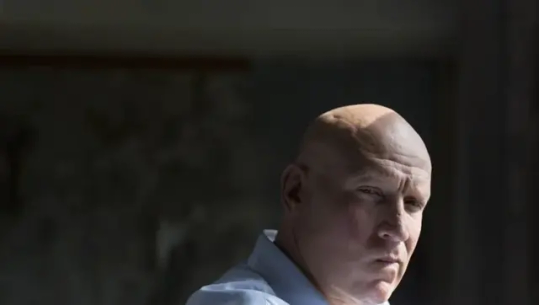

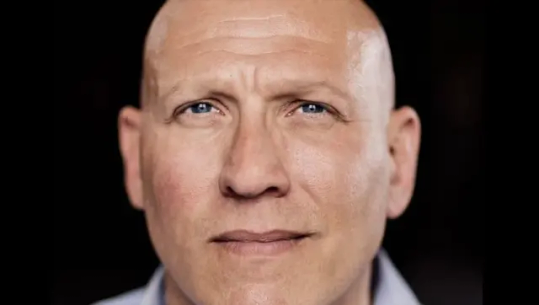
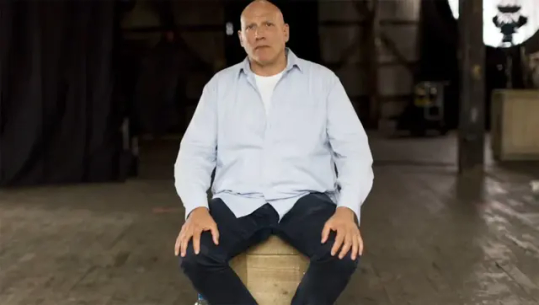

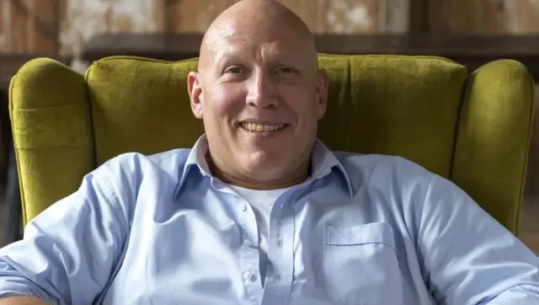
That's how all media works.
All media selects, frames, and focuses utilizing both conscious and unconscious biases.
That's not inherently deceptive - it's how all storytelling functions. Our brains are wired for narrative, it's how our minds work.
Bias can emerge from:
Cultural worldview (like Western vs. Eastern framing)
Political orientation (like left vs. right vs. authoritarian)
Institutional interest (like corporate vs. activist vs. governmental)
Professional constraints (like time limits, editorial priorities, sensationalism for clicks)
A liberal news outlet might cover climate change in terms of justice and inequality. A conservative outlet might instead focus on economic cost and individual freedoms.
Both might be factually accurate. Both are biased. Both have value.
More examples:
A conservative media outlet may emphasize crime statistics.
A progressive media outlet may focus on police accountability.
A US media outlet might frame a Middle Eastern conflict through geopolitics
A local media outlet might highlight the conflict through individual suffering.
All may very well be reporting true facts, but they frame those facts differently.

If you see journalism without bias, let me know - because that's what I'll read when I need to be put to sleep without learning a single thing.
Lying is a completely different animal.
What a Lie Is
Lying goes well beyond having a perspective. Lying is a choice to mislead - an intentional, deliberate falsehood.
Humans can lie with all media: words, pictures, headlines, graphs, statistics...even silence can deceive.
The key ingredient is always intent. Lies are designed to obscure the truth.
Types of Lies in Media:
Outright falsehoods: "Vaccines contain microchips."
Deceptive omissions: Leaving out exculpatory evidence to frame someone unfairly.
Fake sources or data: Citing studies that don’t exist, or misrepresenting real ones.
Image manipulation: Using photos or videos out of context, or editing them deceptively.
A biased report might emphasize some facts over others, but a deceptive one tries to convince you of something the producer of that media knows to be false.
Framing = Bias ≠ Lying
Framing is one of the most common and most misunderstood forms of media bias.
It's not lying - It's the rhetorical and narrative choices that shape how every story is told.
Examples of framing in headlines:
"Unarmed man shot by police" vs. "Suspect neutralized in police operation"
"Protesters clash with police" vs. "Police attack peaceful demonstrators"
"Israel retaliates after attack" vs. "Israeli airstrikes kill civilians"
The facts might not be in dispute. Someone was shot, a protest occurred, airstrikes happened, etc - but how those facts are framed shapes how we interpret them.
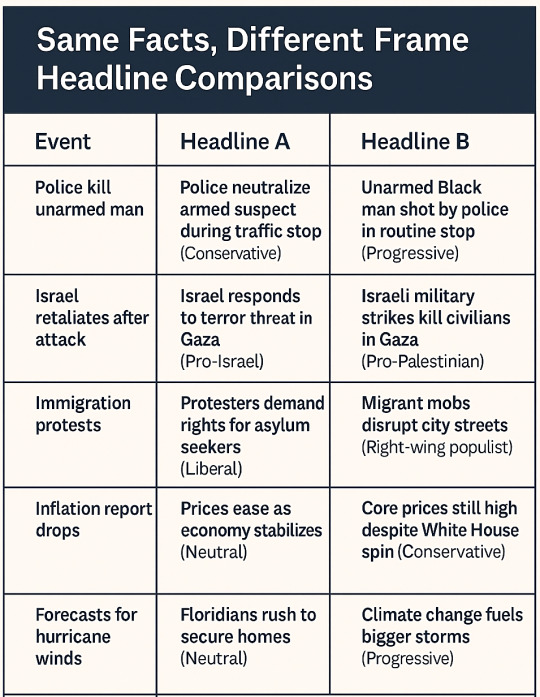
Framing isn't necessarily dishonest. It reflects the values and assumptions of the writer or publication. Understanding framing is essential for media literacy. When you learn to spot frames, you can wring an additional layer of information from the story.
Since it's Unavoidable, Make Bias Work for You
Expecting media to be perfectly neutral is like expecting food to be completely flavorless. It's neither realistic nor desirable. Without a perspective and a framing, a story ceases to be storytelling and our brains...mostly stop processing it.
Every outlet has an editorial mission, an audience, a funding model, a history - so bias is always baked in. That doesn't mean you discard the source. It means you read it strategically, looking for and identifying those biases.
Instead of asking, "Is this source biased?" know in advance that it definitely is.
Instead of asking yourself "should I read this news outlet and regard everything it presents as objective truth"...know that it definitely doesn't, you definitely shouldn't.
Instead, ask yourself questions like:
What kinds of stories does this outlet consistently choose to tell?
Who does the outlet consider trustworthy or quotable?
What kind of loaded language does this outlet use for different groups or events?
Who funds this outlet? Who is its audience? What agenda are they likely to have based on that funding model and target audience?
Bias isn't a disqualifier. It's a clue which tells you more about what you're reading.
Use Biased Sources Without Getting Played
You don't need to trust a source completely to learn something from it. In fact, the most valuable sources are often obviously biased.
1. Identify the Bias
Before even reading, know what kind of outlet you're dealing with. Look at its about page, ownership, funding/revenue model, recurring columnists, and core audience. Does it lean left? Right? Is it globalist? Nationalist? Religious? Secular?
Knowing this lets you anticipate the angle and spot distortions more easily. The more you do it, the easier it gets. After a little practice, you'll see clearly (for example) the huge right wing bias of the Jerusalem Post, the huge left wing bias of Ha'aretz, and how The Times of Israel is mostly pretty disciplined (in their news gathering and framing) about minimizing left/right political biases.
None of these three is perfect, but seeing their usual, institutional biases lets you read them against each other.
2. Use It for Contrast
Biased outlets often highlight stories others avoid or ignore. Fox News may underplay climate change but overplay immigration crime. Al Jazeera will underplay Hamas human rights abuses but spotlight in depth the most embarrassing moments in Israeli politics. The Jerusalem Post will underplay corruption charges against Netanyahu and spotlight the most depraved behaviors committed in the name of Hamas.
Use this to your advantage. Compare coverage across ideological lines. The contrast tells you volumes about outfit AND audience.
3. Look for Hard Facts
Don't quote the adjectives. Quote the data. What happened? When? Where? Who said it? What did the video actually show?
Stop taking an analyst's word as truth - see it as a lens to try on at look at the facts through. If the lens helps it make sense, put it in your back pocket for later use.
Strip away the spin, extract the structure.
4. Cross-Reference Across Angles
Treat each biased source as one side of a triangle. To understand the shape of a thing, you need multiple sides. Balance a left-wing story with a right-wing one. Add an international perspective. Compare them.
Over time, you start seeing the shape of the event instead of the biases of each outfit.
(If you're anything like me, you never want to see or hear another advertisement for Ground News...but still use it sometimes to do exactly this.)
When Bias Becomes Lying
Bias turns into lying when it refuses to admit its own existence or crosses into manipulation. You're dealing with deceptive bias when:
It claims neutrality while advancing a clear agenda
It actively suppresses or distorts opposing views
It refuses to promptly issue corrections or acknowledge errors
It flattens complexity into false binaries like good guys vs. bad guys
It consistently omits key information that would challenge its narrative
It's part of a disinformation campaign (state media, bad actors, bots)
Ask yourself these questions:
Does the outlet ever challenge its own side?
Does it interview or quote those it disagrees with...without distortion?
Does it foster critical thinking or does it push tribal loyalty?
Thesl answers will let you see lying much more quickly.
When evaluating a media claim, ask:
Is this verifiable?
Does this trigger a strong emotional reaction? Was that the goal?
What's missing?
Does this match the tone of propaganda? (overly simplified, emotionally charged, black-and-white framing?)
Is this story meant to inform...or to rally?
And perhaps most importantly:
Do I want this to be true because it confirms something I already believe?
Recognizing your own bias is more critical than spotting it in others. We are all vulnerable to confirmation bias, and most of us seek out what feels good while avoiding what challenges us.
Practice pausing. Breathe a few times between the click and the share. (Confirmation bias will be the topic of a future Signal > Noise.)
Vary Your Media Diet
To understand a complex world, you need inputs from multiple angles.
If you only get your information from one side, you're not informed - you're enlisted.
Real media literacy is not about being neutral. It's about navigating bias with awareness, curiosity, and courage.
That means reading:
Across ideological lines
Across national borders
Across formats (print, visual, audio)
It's not always fun, it takes some time, but it's essential and cwn dramatically reduce your susceptibility to propaganda -
...so go read smart, articulate people you disagree with!
Instead of avoiding bias, learn to read it. Recognize it. Use it. Balance it. Counter it. Triangulate past it.
And when you find actual deception? Name it and reject it.
That's media literacy.
#jumblr#media literacy#information literacy#How to read the news#Signal > Noise#bias vs lying#media bias#media dishonesty#propaganda#Media ecology#epistemology
39 notes
·
View notes
Note
https://www.reddit.com/r/redscarepod/comments/1hepfrc/luigis_lost_post_from_the_onebag_subreddit_gives/
Hey im the anon who brought up the asia list a few days ago! I read it here!
“I originally wrote this as a personal exercise, but figured I may as well post here in case someone finds it interesting/useful. It's half-journal, half-packing list and details my setup that I find to be the perfect balance between minimalism and practicality. For the last 2 months specifically, it’s held up great in Asia across various countries and climates, and throughout some cross-country motorcycling. I remember one time as a young child playing with friends. Fantasizing, we each sketched our ideal “dream home.” Everyone else drew intricate mansions, complete with elaborate swimming pools and multi-car garages. I sketched the floor plan of a small square house, with four identically-sized square rooms: a bedroom, a living room, a kitchen/dining room, and a bathroom/laundry room. A place to sleep, a place to be, a place to eat, and a place to.. uh.. excrete. It was everything I needed. Nothing more, nothing less. They thought I was weird. I thought their mansions were full of lots of bullshit. I suppose I’ve always been hyper-obsessed with efficiency, and I’ve never been very materialistic. Those traits have persisted into adulthood. They are why I became an engineer. Today, I may have even one-upped my kid self: perhaps the ultimate vessel for minimal, efficient living - surpassing even a tiny square home - is a single backpack. To be clear, I don’t live out of a backpack full time, nor do I want to, but I enjoy doing so comfortably for months at a time. For certain discrete periods of time, when traveling, and wanting to fully engage in the experience, it’s a useful practice. Why one bag? First, there are the practical reasons regarding air travel. “No rushing to the airport early to check bags, no searching for an overhead compartment, no bag fees or worrying about stuff getting lost, and no adjusting plans to drop off luggage before an adventure,” explains indefinite onebagger Jeremy Maluf. Second, there are the more philosophical reasons. There is a sense of weightlessness, freedom, and self-sufficiency that accompanies one bag travel. At some point, a bag becomes small and light enough that it can be carried without consequence, no longer of any meaningful concern. “Things” are simply no longer a factor in mobility. Further, the constraint of a single bag is a useful practice in intentionality, and it’s a good reminder that we’re able to go long periods of time without needing many things. Finally, without luggage there is a very real sense of traveling as an adventurer, rather than as a tourist. It has taken me several years of trial and error, as well as a good chunk of time obsessively researching small things, to whittle my gear down comfortably to a single inconspicuous backpack. What follows is a breakdown of my bag. I believe it achieves the perfect balance: any more gear, and the bulk/weight of the bag becomes cumbersome; any less gear, and it becomes impractically minimalistic for daily needs. This post is far from original. It’s just a drop in the ocean of travel influencer blogs detailing onebag setups. As such, I’m not trying to impart any groundbreaking wisdom here. It’s just a personal exercise in appreciating what I have, admiring its efficiency, and brainstorming potential tweaks. Most importantly, it was just fun to compile. I’m not trying to sell anything here (none of the links below are affiliate links), though some part of me does hope someone else may find this list useful.”









@tomatorome !!!
still waiting for his one can post😣
38 notes
·
View notes
Text
Let's explore the ninth art... (suite)
After looking at the origins of the BD, the deep roots, let's peek at when it "truly" began.
As we leave the 19th century to enter in the 20th, we find BD as we know it finally appearing - mainly through the landmark that is "Les aventures de Zig et Puce" (or "Zig et Puce"), by Saint-Ogan (1925), which on top of creating the page-display that we know today (it is called "le gaufrier", "the waffle-iron", THE traditional page-structure of a BD) was also the first BD to use speech bubbles. It is considered one of the founders of the BD proper alongside the early Tintin comics - which soon became a visual reference as Tintin himself became a true element of pop-culture that others tried to imitate.
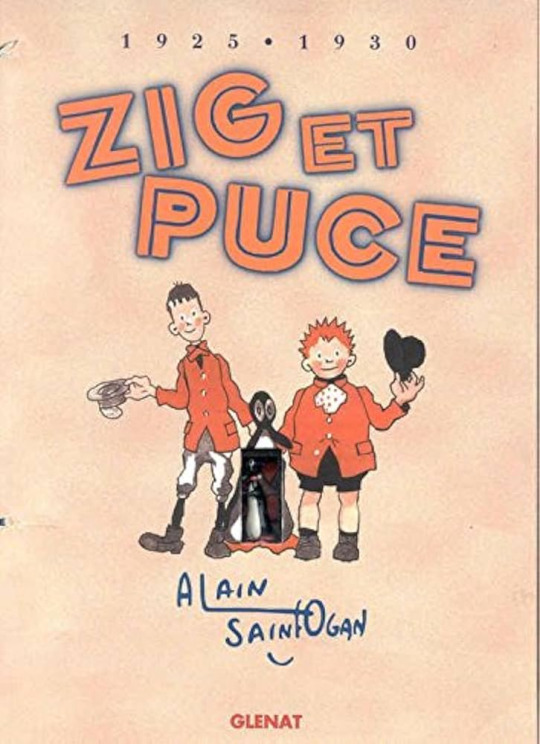
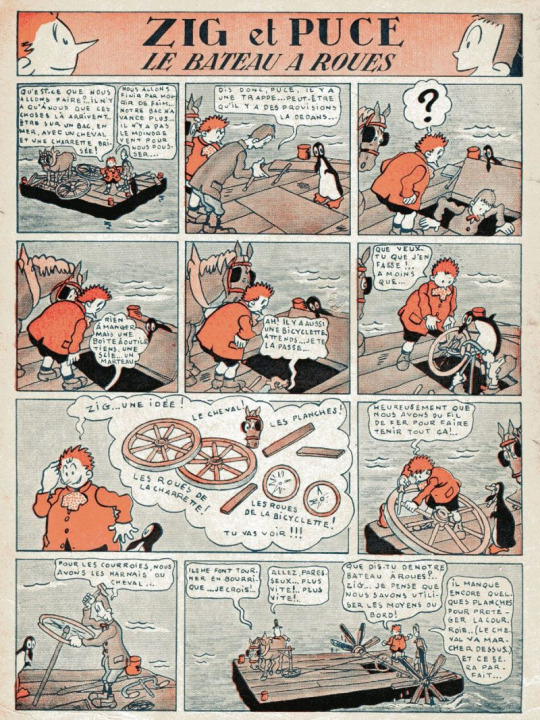
I talked before of the importance of "Le Journal de Mickey", from 1934 onward. An illustrated magazine for children, made in France, which proved very popular and successful - and despite its name, this magazine wasn't only about "Mickey comics". While yes the magazine was originally created to translate in French the comics of Mickey's adventures, this magazine quickly became an outlet in France for many various popular American comics of the time. A true variety appeared within its pages, with stories as much for young children as for older teenagers. This is why I said earlier that Le Journal de Mickey, by importing American models, "opened" the horizon of BD-creation in France (it notably had quite an influence on the variety of ways you could use speech bubbles - something that could also be found within the Tintin comics where the gestures, movements and physical actions of the characters were ponctuated by specific exclamations and declarations). "Terry and the pirates" was, for example, one of the early American comics that influenced a lot early Franco-Belgian comics.
As a result, during the 30s, the "illustrated tale" or "drawn story" format we saw earlier with the proto-BDs gets completely dropped, replaced by proper "comics", or rather a model of BD mixing the Tintin structure and the American comics influence. A shift of style which can be seen, for example, with how there's a shift in the balance between text and image - with series like "La famille Fenouillard" you could just read the text without the images, and it wouldn't harm the story, the images were here merely to "help" visualize or imagine what the text was about or bring additional elements to the descriptions. But with Tintin onward, the drawing becomes the first thing of importance and the main way to convey the narration, with sometimes the text becoming redundant with the image.
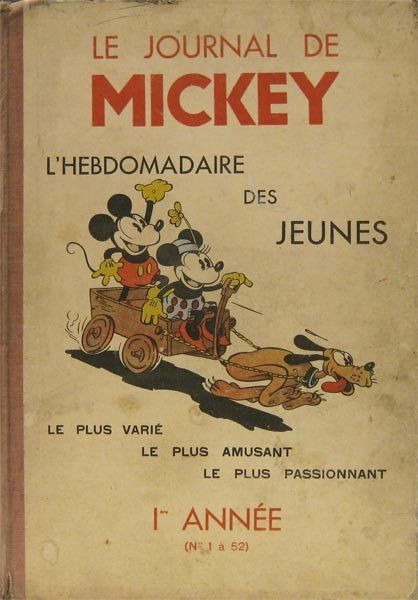
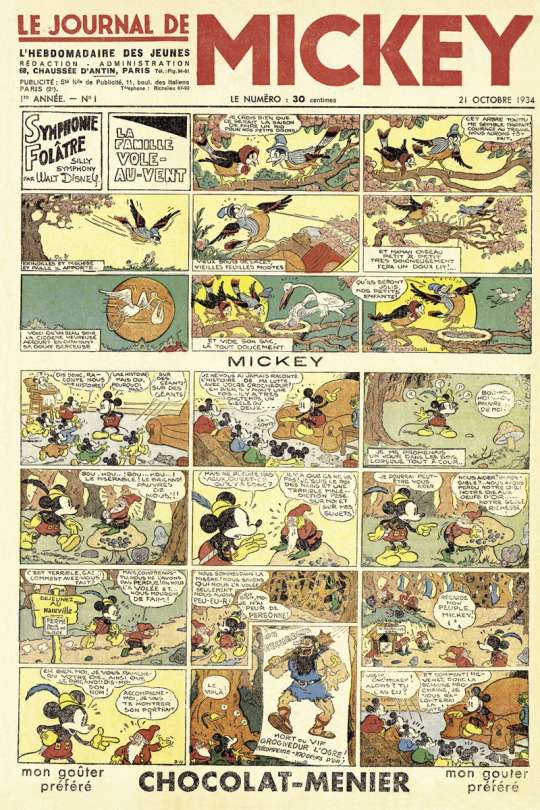
Mind you, it does not mean that the text-heavy BD was gone... A lot of the early famous BD and first-generation successes still relied heavily on the text - such as the Bécassine BDs where the images cannot be understood without the text, or "Les Pieds Nickelés" where they rely on a more complex narrative that makes the drawings hard to understand on their own. They still use speech bubbles, but they are rare and punctual. Because at the time the "bubbles" were not an obligatory rule - merely a graphic choice, to be used more or less depending on the creator's preferences.
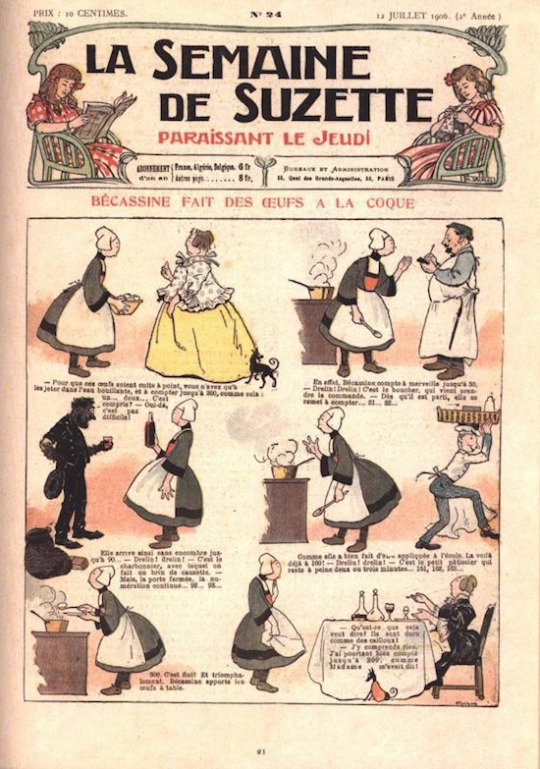
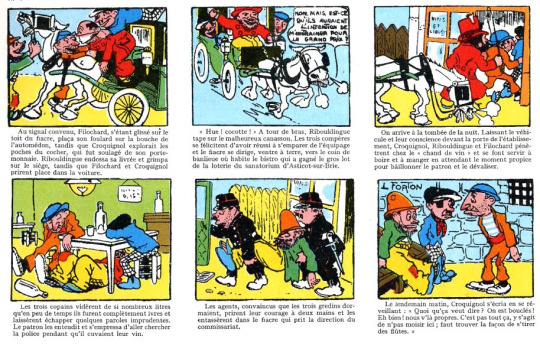
Despite BD finally reaching its form, one will have to wait until the end of World War II to see it gain the power and scope it has today - only for its newfound independance and autonomy to be immediately challenged.
For you see, during World War II in France, the "youth parutations" (of which BDs were a part of) were limited and tightly controlled. On one side you had the physical and economical constraint of the lack of paper available, on the other you had the socio-political censorship enacted by the Occupation. As a result it was a very "dry" time for BD. When World War II was over, many new "youth publications" appeared, a true boom of creativity once the constraints were over... And yet the political control over the "reading of the young" was not over. We were still in the continuity of the mass propagandas of the inter-war era and the Second World War - politics understood that if you wanted to keep things under a "right" order, you needed to make sure children wouldn't read "any type of thing"... And in France, this desire to control youth-reading was taken over by the most improbable and humoristic duo possible.
The Catholic Church and the Communist Party. Yep. In the 1940s and 1950s Catholicism was still a real ower in France, and they wanted to control what children read so that they could still have a hand over their education (despite the law of separation of the Church and the State from 1905). The Communist Party of France, meanwhile, wanted to prevent the French territory from being "invaded" by products of the American culture, and so were ready to block any American comic trying to appear on French land. United despite their divergence, the Catholic-Communist duo managed to bring "la loi sur les publications pour la jeunesse" of 1949, the "law on youth publications". This law authorized and legalized a "pre-censorship" (aka, something would be forbidden from being published or released) for any BD that depicted violence or sexuality. And if the "surveillance" process failed and a BD not fitting the criteria was still published, the law authorized it being forbidden again by being cut out or removed, one way or another. Quite frighteningly, the law was still there by the time I took my class about the history of BD - it had been modified, with lot of things added to it to "soften" it up, and nobody had been using it anymore, but it still had not been removed... And could be resurrected if someone really had something against French comics.
This 1949 law was famously the law that ended the Hara-Kiri journal after it "criticized" too much the général de Gaulle, forcing the publication to become "Charlie Hedbo" - that you might know due to the tragic terrorist attacks of 2015. This law was mainly used for political publications - it censored newspapers caricatures, and was a way for organizations to go around the fundamental "freedom of media", "la liberté de la presse", ensured by the very foundations of the French Republic. But it also impacted BDs a lot... Which is why BD productions displaced itself from France to Belgium! The editors remained in France, but the BDs themselves came from the Belgian land and were created there - hence why today we still refer to it as the "Franco-Belgian BD".


As I said before, while this era was dominated by the Franco-Belgian production, which was one of the leaders in Europe, other countries still had their own local productions. Italy had its own BDs, very popular and a mass-success. Spain had its BD - which appeared with quite some difficulities as it had to deal with Franco's rule and censorship. In England specific comics appeared which were hybrids between the American comics and the European BDs, and became their own "school" of sequential art.
But in France and Belgium, very quickly two "poles" or two main "sides" of the BD appeared. Two rival "schools", two specific aesthetics and methods. They were not literal schools mind you, they were not defined movements or closed circles or clubs with specific leaders. They were rather movements born out of one or two major figures (Hergé, Franquin) who had many imitators and ended up forming a specific "type" of BD.
On one side: the "ligne clair" movement (the clear line), also called the "Bruxelles school", connected to the Journal de Tintin. It is, of course, Tintin itself (by Hergé), or the productions of Edgar P. Jacobs (the "father of Blake and Mortimer"), or those of Jacques Martin (the man behind the "Alix" series). Tintin was the one that started it all, technically speaking ; from 1946 onward a "Journal de Tintin" was created publishing not only Tintin adventures, but also affiliated or similar comics that imitated Tintin's "style" - this style that from 1977 onward would be called "la ligne clair", "the clear line". Key elements of it could be listed as: Deep, complex landscapes filled with details ; a careful visual "mise en scène" of the characters with "decomposed" actions shown step by step ; an effort to produce a "realist" effect yet with a simplification of human features... And most importantly, a neat, "clear" line (hence the name) that clealy separates the colors, resulting in very little use of shadows or color nuances. One of the favorite techniques of the "clear line" school is to create suspens through "static representations", actions being divided into "still-shots", so to speak, as if someone paused a video. This school notably relied still a lot on text narrative - especially through text-frames informing the reader of a lot of things needed to get the story.
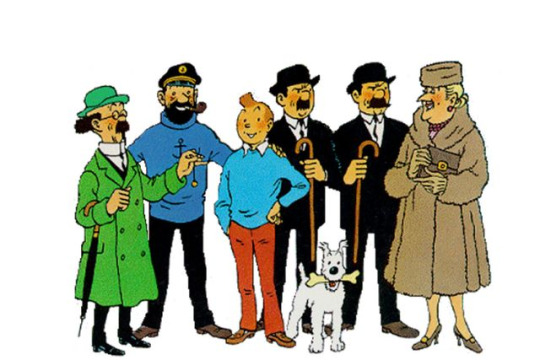


On the other side: the "school of Marcinelle", linked to the Journal de Spirou (a journal created in response to the Journal de Tintin). Just like Hergé was the central figure of the Bruxelles school, here the "main creator" is Franquin - with his works defining the school. Spirou and Fantasio, Gaston Lagaffe, the adventures of the Marsupilami...
This school can be recognized by less text, less pictures, a simplified storyline as well as a simplified "gaufrier", a simpler page-display... which however allows for much larger drawings and much more spacious visuals, or more for a more disorderdly, "anarchic" organizaton of the frames. This school uses a lot color as a powerful, strong, expressive thing, that determine the ambiance and the feel of each scenes, and almost "invade" the drawing. This aesthetic notably plays a lot on color contrast.
Just like with the Hergé school the characters' designs are "simple", but not a "simple realism" - here we have a simplification that accentuates the traits almost to the point of caricature. As a result, the Marcinelle school has often been called "l'esthétique des gros nez" (the big nose aesthetic) - thanks to how a lot of Franquin's character had large, big round noses. Yet it wasn't used for satirical purpose, as the proto-Bd used to do. Rather this "simplification", that is also done by Hergé (though in a more realistic effort) is here to answer the logic of the first-generation BD - a logic of "typification". The reader must be "helped" and "guided" through the visual storytelling, and thus the designs are made recognizable and iconic, by the characters becoming "visual types". But whereas Hergé uses common elements and recognizable traits to offer a "simple realism", Franquin rather told more fantastical, humoristic tales, with a lot of imaginary creations and unrealistic characters - the Schtroumpfs (the Smurfs) belong to the Franquin school, and of course as said above the Marsupilami too.
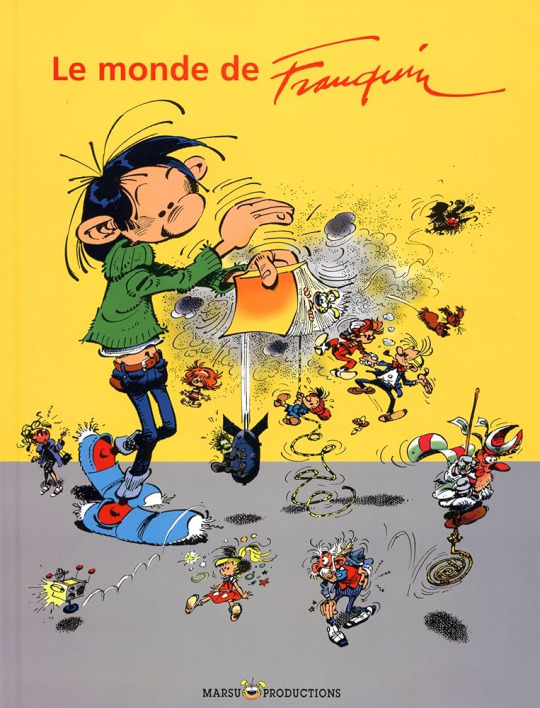
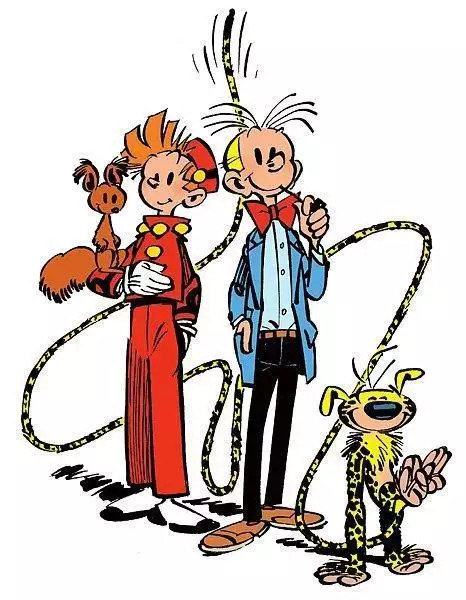

As a result, you had the "trinity of Journals" in this era, the three main outlets and sources for BD being the Tintin Journal, the Spirou Journal and, as I said above, the Mickey Journal - with the Journal de Mickey working with a unique "mondial strategy" of not just bringing American comics and characters oversea, but also highlighting a "local" production. Le Journal de Mickey was, as I said, a French-specific magazine, and thus it notably allowed specific, unique comics created solely in France and not found in America. And similar iterations and incarnations of the Mickey Magazine were found, in Italy or in England, where local Italian or British artists created their own unique Mickey adventures, not found in America.
In France, a famous example would be Pierre Nicolas' BD "Mickey à travers les siècles" (Mickey through the centuries) or "Mickey explore le temps" (Mickey explores time), in which Mickey travels through the history of the world, and of France.
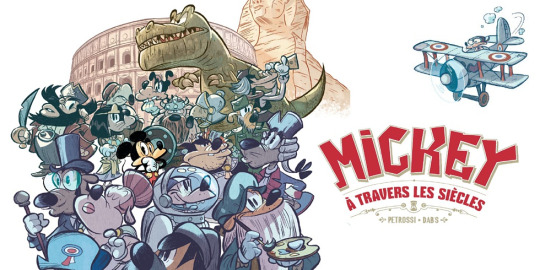
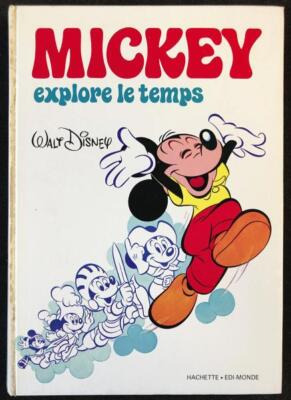
Another famous BD outlet was the "Vaillant" magazine, that would later become the famous "Journal de Pif"... And Vaillant is a very interesting because it published, for example, the BD "Les pionniers de l'espérance" (The pioneers of hope). And this BD is notorious for having... a lot of female characters.
It doesn't sound extraordinary and yet it was! For you see, in these first-generation BDs, women are not very present or important in the stories... Because of the censorship I told you about. Indeed, the law about the censorship of youth publication deemed that sexuality in stories for children was illegal, due to the mere evocation of sex being considered "nefarious" and "bad" for the child's education and development. And this resulted in... not presenting couples or lovers, because it would lead children to ask questions about sex or think about it. And in turn this resulted in... women being erased or not included in stories, to avoid any possible form of romance or attraction. On top of this, at the time it became known that BDs were mostly "for boys" and had a mainly male audience. It was widely considered that little girls were interested in other types of stories, and that things other than BDs were most suited for them. This cliche and stereotype became an enforced standard or a very implicit "rule" that had to be strongly fought and battled later on, as women had to truly struggle to appear as both A) a worthy audience and B) legitimate creators in the BD world. But we are jumping a bit ahead in time...
So why would Les Pionniers de l'Espérance have so many female characters? Simple! The magazine "Vaillant" in which it was published was a Communist journal for adults and young boys. This affiliation with the Communist Party (the one that enforced the BD censorship) allowed them to avoid the harshest consequences of it - and while adding various female characters, they made sure to follow "the rule" by never having any romance in any form or shape.
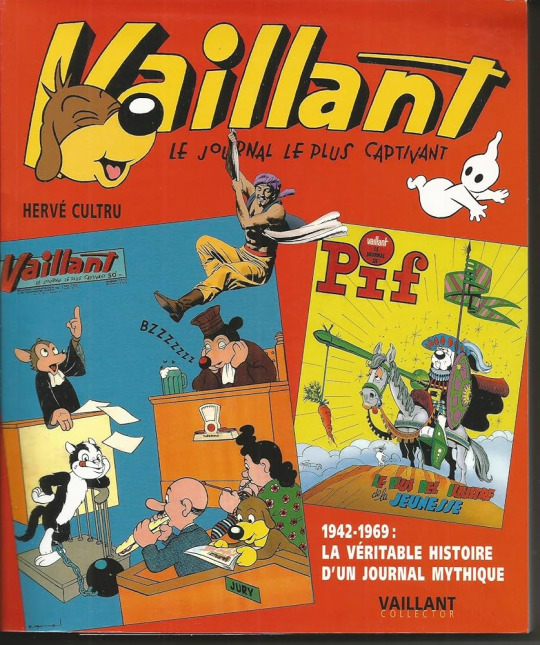
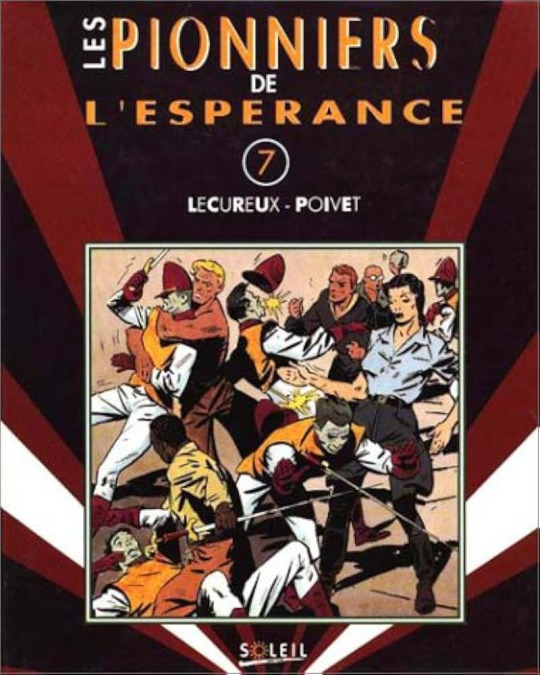
For the "masculinization" and the "male-dominated world" of the BD to be challenged by feminity and feminism, one will have to wait until the 60s and 70s...
See you next post!
#bd#let's explore the ninth art#bande dessinée#french comics#french history#french things#france#censorship#comic books#tintin#smurfs#spirou and fantasio#marsupilami#mickey
20 notes
·
View notes
Note
Can you tell us anything about the Creature Commandos? I read a brief blurb about them in a book of "Weird War Tales" with other stuff like the GI Robot and the Boy Commandos, but trying to google anything on them just leads to debates as to whether or not they were actually supernatural or some kind of science project.

Oh dammit, James Gunn's little Inglorious Bastards-esque cartoon just came out didn't it? Jokes on you guys though, I actually ordered and read the appropriate books ahead of time! You're not slick!/s
Thank you for providing the image for this one so I don't have to go looking for it. (I truly hope you did not watch the old TV movie this was made for though. My god this poster it the best part of it)
To answer the most pressing question, they're a science experiment. Buckle in because if you thought your opinion of the US Army could not get any lower!
The Creature Commandos were formed in 1941 under the auspices of an outfit known as Project M which was the pot the US Army threw money into with the expectation it would use them to come up with super weapons to end the Nazi threat with no oversight or ethical constraint. They were responsible for the construction of G.I Robot as you mentioned and one of their failed experiments even granted New York native Joan Dale the powers she would use to become Miss America.
The Commandos specifically were the brainchild of one Dr. Myron Mazurksy, a real mad scientist type with the pet theory that the tales of monsters and ghouls making up the bulk of human mythology were the triggers for an kind of evolutionary fear, his hypothesis was that altering subjects through chemical and surgical methods to resemble these monsters of legend would give them an edge on the battlefield. (Of course we know now that these stories are not psychological misinterpretations at all but instead tales of actual beings that really do exist)
The Creature Commandos were made up of four founding members:
Private Warren Griffith was diagnosed with psychological lycanthropy and so was remanded into Project M's custody where he was surgically altered into and actual wolf man with very little conscious control of the time of his painful metamorphosis. He had committed no crime other than being considered psychologically unfit for service.
Pilot Officer Vincent Velcoro, a member of the Royal Air Force convicted of high treason for striking a well connected superior officer. Remanded into American custody without any due process under British military law he was given the choice of a 30 year sentence or experimentation which turned him into a human vampire, forced to drink blood at least once a day and only able to stomach consuming raw meat.
Private Elliot "Lucky" Taylor, a newly minted marine who was nearly killed by a land mine during a war gaming exercise. Surgically reconstructed by Project M his vocal cords were severed by the procedure, his family was told he was KIA and Taylor himself was never consulted about the procedure nor was he allowed to leave after the fact. Again he had committed no crime and was not even unfit for service, simply fed into the mill for the sake of "progress"
and Dr Myrra Rhodes who, when operating upon a wounded soldier within Project M's compound was mutated by a poorly secured batch of mutagen chemicals, transformed into a living medusa. She was also unable to leave military custody and was listed as KIA, losing her entire life due to Project M's negligence.
They were placed under the command of one Lieutenant Matt Shrieve who noted in his later unearthed war journal a personal loathing for his "freakish" subordinates whom he treated with inhuman disdain. Providing for their needs only reluctantly and below the standards of what they would have received in a brig back home. They were sent on what were, frankly, suicide missions, managing to survive time and again based on good luck and the members' trust in one another above all.
A truly demonstrative directive, unearthed by a freedom of information request submitted by their families well after the fact showed that the Creature Commandos were under command from the highest echelon that their existence be kept an absolute secret from the All Star Squadron or any of its members. A personal note, written by a redacted command officer at the bottom of the ledger opines
"The long underwear freaks would just get their bleeding hearts in a twist anyway."
Meaning that the army specifically kept the Commandos a secret from the Squadron, KNOWING that the Squadron would object to the less than human conditions and expectations of the Commandos and most likely would have seen to their emancipation under Squadron protection.
As the war drew to a close, the Commandos were marked for execution by firing squad. No trial or crime was ever given as reason. "Spared" from execution they were sent in a rocket toward the then ongoing battle of Berlin to do some final "good" or die trying.
Their presence is not noted at the battle and their bodies, or indeed their trails have never been found. Make of that what you will.
#dc#dcu#dc comics#dc universe#superhero#comics#tw unreality#unreality#unreality blog#ask game#ask blog#asks open#please interact#worldbuilding#creature commandos#patchwork#wolfpack#dr medusa#vincent velcoro
47 notes
·
View notes